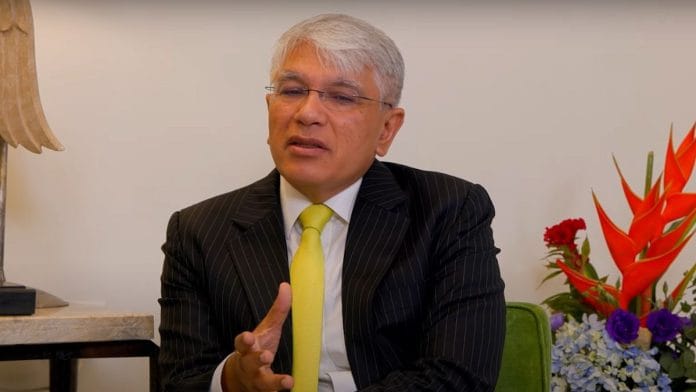New Delhi: India does not need to sacrifice its democracy to match China’s economic success, said Manish Sabharwal, author and Vice-Chairman of staffing solutions and human capital firm, TeamLease.
During his conversation with journalist and author Vir Sanghvi for ThePrint Dialogues, Sabharwal rubbished the claims by several politicians and economists that the only way India can grow like China is by sacrificing its democracy. Instead, he blamed India’s failure to transition into a non-farm sector-led economy and its neglect in terms of building human capital.
“I think that the success of China probably is 20 percent related to their dictatorial or their autocratic or their communist tendencies. The other part of it is just non-farm job creation. We could have attracted the same foreign direct investment, if we had lowered our regulatory cholesterol, built the infrastructure, and fixed our human capital,” said Sabharwal.
He further pointed out that with an increased focus on resource development, India received 50 percent of its foreign direct investment since 1947 in the past five years. According to him, the ease-of-trade policies, high resource allocation and servitisation were pivotal in India’s economic success story.
Also Read: PM’s economic advisor asks if India needs a new poverty line, says multidimensional index not enough
‘Toxic piece of regulation’
Sabharwal discussed the 1991 liberalisation policy, which was responsible for significantly changing the economic landscape of India.
Until 1991, India and China had comparable GDPs, he said.
In fact, India was ahead of China in terms of per capita income until 1990. India’s per capita income 33 years ago was $367, while China’s was $317. It was the last time India was ahead of China. According to the latest prediction by the International Monetary Fund (IMF), China’s per capita income in 2023 was $12,514, whereas that of India stood at $2,500.
After both countries embraced liberalisation in 1991, China grew at 11.7 percent in the 1990s (versus India’s 5.6 percent), then 16.5 percent in the 2000s (against India’s 6.5 percent), and 8.8 percent in the 2010s (versus India’s 5.1 percent).
According to Sabharwal, much of this growth was due to quicker privatisation, major labour market reforms, and openness to international trade and foreign direct investment. In contrast, India’s 1955 Avadi resolution played the bad cop.
“It was the social adoption of socialism and the kneecapping of the private sector, the commanding heights of the public sector, nationalising banks… All the chaos that was created for the private sector comes from the 1955 Avadi resolution. It was embedded in the 1956 second five-year plan. So, I think that was a toxic piece of regulation,” Sabharwal told ThePrint.
He further added that the business environment in India has not always been conducive to private players. He mentioned the raids on CEOs of companies and the obligation to adhere to “a thousand compliances” that give room to corruption in the country’s business environment.
Other reforms that, according to Sabharwal, should have been included in the 1991 economic reforms were formalisation and education.
Formalising the economy could have integrated thousands of informal workers into the formal ecosystem, guaranteeing better tax revenues with an increased tax-to-GDP ratio.
Education, Sabharwal said, is crucial for developing human capital, as labour is India’s biggest resource.
However, he expressed optimism about the boost the COVID-19 pandemic gave to India’s digital and software development sector.
(Edited by Mannat Chugh)






